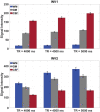Simultaneous Optimization of MP2RAGE T1 -weighted (UNI) and FLuid And White matter Suppression (FLAWS) brain images at 7T using Extended Phase Graph (EPG) Simulations
- PMID: 36352772
- PMCID: PMC10100108
- DOI: 10.1002/mrm.29479
Simultaneous Optimization of MP2RAGE T1 -weighted (UNI) and FLuid And White matter Suppression (FLAWS) brain images at 7T using Extended Phase Graph (EPG) Simulations
Abstract
Purpose: The MP2RAGE sequence is typically optimized for either T1 -weighted uniform image (UNI) or gray matter-dominant fluid and white matter suppression (FLAWS) contrast images. Here, the purpose was to optimize an MP2RAGE protocol at 7 Tesla to provide UNI and FLAWS images simultaneously in a clinically applicable acquisition time at <0.7 mm isotropic resolution.
Methods: Using the extended phase graph formalism, the signal evolution of the MP2RAGE sequence was simulated incorporating T2 relaxation, diffusion, RF spoiling, and B1 + variability. Flip angles and TI were optimized at different TRs (TRMP2RAGE ) to produce an optimal contrast-to-noise ratio for UNI and FLAWS images. Simulation results were validated by comparison to MP2RAGE brain scans of 5 healthy subjects, and a final protocol at TRMP2RAGE = 4000 ms was applied in 19 subjects aged 8-62 years with and without epilepsy.
Results: FLAWS contrast images could be obtained while maintaining >85% of the optimal UNI contrast-to-noise ratio. Using TI1 /TI2 /TRMP2RAGE of 650/2280/4000 ms, 6/8 partial Fourier in the inner phase-encoding direction, and GRAPPA factor = 4 in the other, images with 0.65 mm isotropic resolution were produced in <7.5 min. The contrast-to-noise ratio was around 20% smaller at TRMP2RAGE = 4000 ms compared to that at TRMP2RAGE = 5000 ms; however, the 20% shorter duration makes TRMP2RAGE = 4000 ms a good candidate for clinical applications example, pediatrics.
Conclusion: FLAWS and UNI images could be obtained in a single scan with 0.65 mm isotropic resolution, providing a set of high-contrast images and full brain coverage in a clinically applicable scan time. Images with excellent anatomical detail were demonstrated over a wide age range using the optimized parameter set.
Keywords: 7T; FLAWS; MP2RAGE; MRI; ultrahigh field.
© 2022 The Authors. Magnetic Resonance in Medicine published by Wiley Periodicals LLC on behalf of International Society for Magnetic Resonance in Medicine.
Conflict of interest statement
Raphael Tomi‐Tricot is an employee at Siemens Healthineers, and Ronald Mooiweer is seconded to Siemens Healthineers.
Figures







Similar articles
-
A closer look: pediatric neuroimaging at 7T.Pediatr Radiol. 2025 May;55(6):1071-1087. doi: 10.1007/s00247-025-06231-4. Epub 2025 Apr 21. Pediatr Radiol. 2025. PMID: 40257498 Review.
-
High-resolution multi-T1 -weighted contrast and T1 mapping with low sensitivity using the fluid and white matter suppression (FLAWS) sequence at 7T.Magn Reson Med. 2021 Mar;85(3):1364-1378. doi: 10.1002/mrm.28517. Epub 2020 Sep 29. Magn Reson Med. 2021. PMID: 32989788
-
Fluid and White Matter Suppression: New Sensitive 3 T Magnetic Resonance Imaging Contrasts for Cortical Lesion Detection in Multiple Sclerosis.Invest Radiol. 2022 Sep 1;57(9):592-600. doi: 10.1097/RLI.0000000000000877. Epub 2022 May 3. Invest Radiol. 2022. PMID: 35510874 Free PMC article.
-
Pushing MP2RAGE boundaries: Ultimate time-efficient parameterization combined with exhaustive T1 synthetic contrasts.Magn Reson Med. 2024 Apr;91(4):1608-1624. doi: 10.1002/mrm.29948. Epub 2023 Dec 15. Magn Reson Med. 2024. PMID: 38102807
-
Malformations of cortical development: The role of 7-Tesla magnetic resonance imaging in diagnosis.Rev Neurol (Paris). 2019 Mar;175(3):157-162. doi: 10.1016/j.neurol.2019.01.393. Epub 2019 Mar 1. Rev Neurol (Paris). 2019. PMID: 30827579 Review.
Cited by
-
Extent of piriform cortex resection in children with temporal lobe epilepsy.Ann Clin Transl Neurol. 2023 Sep;10(9):1613-1622. doi: 10.1002/acn3.51852. Epub 2023 Jul 20. Ann Clin Transl Neurol. 2023. PMID: 37475156 Free PMC article.
-
A closer look: pediatric neuroimaging at 7T.Pediatr Radiol. 2025 May;55(6):1071-1087. doi: 10.1007/s00247-025-06231-4. Epub 2025 Apr 21. Pediatr Radiol. 2025. PMID: 40257498 Review.
References
-
- Marques JP, Kober T, Krueger G, van der Zwaag W, Van de Moortele PF, Gruetter R. MP2RAGE, a self bias‐field corrected sequence for improved segmentation and T1‐mapping at high field. Neuroimage. 2010;49:1271‐1281. - PubMed
-
- Mugler JP, Brookeman JR. Three‐dimensional magnetization‐prepared rapid gradient‐echo imaging (3D MPRAGE). Magn Reson Med. 1990;15:152‐157. - PubMed
-
- Tanner M, Gambarota G, Kober T, et al. Fluid and white matter suppression with the MP2RAGE sequence. J Magn Reson Imaging. 2012;35:1063‐1070. - PubMed
-
- Sudhyadhom A, Haq IU, Foote KD, Okun MS, Bova FJ. A high resolution and high contrast MRI for differentiation of subcortical structures for DBS targeting: the fast gray matter acquisition T1 inversion recovery (FGATIR). Neuroimage. 2009;47:T44‐T52. - PubMed
Publication types
MeSH terms
Grants and funding
LinkOut - more resources
Full Text Sources

